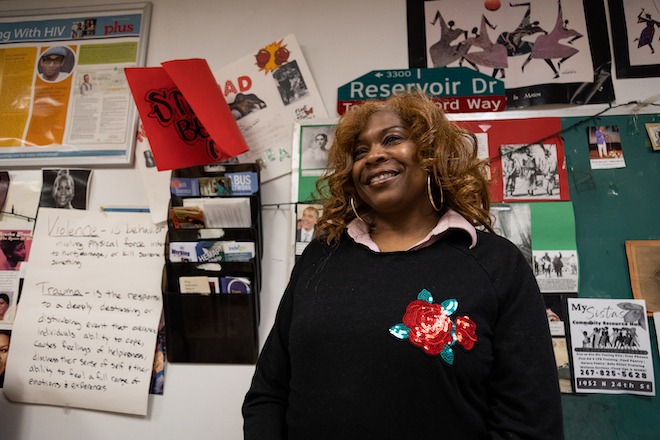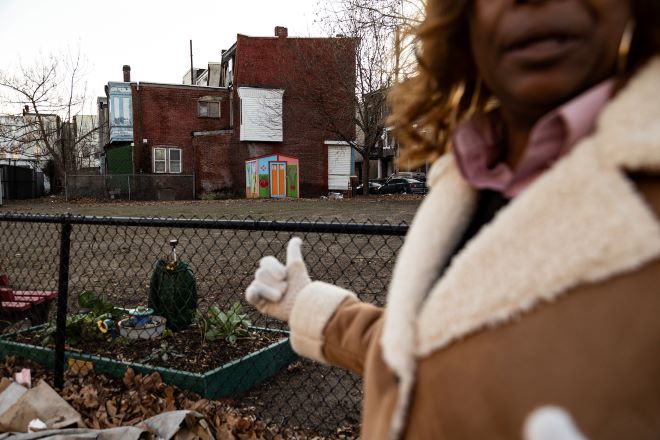On a blustery Thursday afternoon, Tonnetta Graham arrives at the Community Partnership School, a private K-through-5 school on Glenwood Avenue in Philadelphia’s Strawberry Mansion neighborhood, for a demonstration of a youth test project. The “playful learning lab” was funded in part by a grant from KABOOM, a national nonprofit that works with communities to build playgrounds. Curious neighbors have come to ask questions about the project and provide their input.
“Today, these students are my focus group,” Graham, who has served as president of the Strawberry Mansion Community Development Corporation for the last 15 years, tells the gathered crowd, which includes 25 children and representatives of community groups and nonprofit agencies helping to facilitate the afternoon activities. “The learning lab will be an extension of an activity park we are going to include in the yard next to our John Coltrane House project. I’m here today to get a sense of what children really want to do so we can create the best learning and playing experience for them.”
Clad in sneakers, Graham playfully runs behind the children, ages 6 to 10, asking questions and resembling the teacher she was early in her professional life.

It’s not a scene where you might expect to encounter one of the city’s longest-tenured community development officials. Yet Graham’s commitment to including community voices in neighborhood projects, no matter how big or small, has long exemplified her leadership style.
That leadership may be needed more than at any other time in Graham’s tenure at the Strawberry Mansion CDC. As new pockets of housing construction continue to sprout throughout the neighborhood, long-time residents — many who are descendants of the neighborhood’s earliest African American arrivals — worry that encroaching development may not only price them out but permanently alter the sense of community they and Graham have spent years nurturing.

“I was trying to take a shower”
The decor of the shared offices of the Strawberry Mansion CDC and the Strawberry Mansion Neighborhood Action Center offers a glimpse of the organization’s impact over the years. Old black-and-white photos of children, community residents and projects line the walls. Former coworkers and children from the neighborhood stop by throughout the workday for a shared laugh or a hug.
Yet the origins of Graham’s career in activism were far more humble. “I was trying to take a shower,” she says.
It was the 1980s, and she had recently returned to Philadelphia after graduating college to teach at Strawberry Mansion High School. Years before, her grandmother bought a house in the neighborhood, back when many residents had moved to Philadelphia from the South during the Great Migration. “I was reared in this community when it was primarily African American working class,” Graham says. “Everybody knew their neighbors. I came up with that village environment. Most of my family lived on the same block. I had real pride in where I lived.”
Graham says she immediately noticed how years of lacking resources and investment had affected her neighborhood. “When I arrived back from college, the neighborhood had changed,” she says.
One summer day, she was trying to take a shower when she found the water pressure unusually low. The reason: Several fire hydrants had been turned on simultaneously to help area residents beat the heat. The “water plugs,” as hydrants are called in Strawberry Mansion, were the only form of relief — the neighborhood pool had been closed for years.
“I understand that the neighborhood needs development, but we are a neighborhood that should be respected. Planned with — not planned for.” — Tonnetta Graham
“I contacted then-Councilman John Street’s office to ask about the pool issue,” she says. She didn’t get an answer, but Street’s community liaison, Melvin Smith, asked her to come to a meeting. “Five years later, we had a pool.”
While Graham was a teacher at Strawberry Mansion High School, she deepened her commitment to community activism. She first volunteered on the Mander Recreation Advisory Committee and later at the Strawberry Mansion CDC. In 2009, after the then-president of the Strawberry Mansion CDC, Denise Clark, became ill, the organization’s board tapped Graham to become the president.
Over the years, Graham’s efforts — project by project, block by block — have helped Graham and the Strawberry Mansion CDC improve the everyday lives of people who live there, thanks to everything from resident assistance initiatives to neighborhood preservation programs.
Among other efforts, the organization helped coordinate the Vacant Lot Maintenance and Corridor Clean Up program, which provides manpower and financial resources to fight dumping on empty lots — a common, unsightly blight in traditionally marginalized communities. It also spearheaded the installation of the Indego bike share stations throughout Strawberry Mansion and helped shape its discounted rates for neighborhood residents.
More broadly, the organization has also undertaken programs to guide how and where development happens in the neighborhood. The Strawberry Mansion Neighborhood Conservation Overlay, for example, provided guidance for new construction that provides limitations on the height of roof decks so they wouldn’t tower over adjoining buildings that have been in existence for decades, a method used for years in some of Philadelphia’s more affluent neighborhoods. “I understand that the neighborhood needs development, but we are a neighborhood that should be respected. Planned with — not planned for,” Graham says.

Building a future — while keeping the neighborhood intact
To spend time with Graham is to be in constant motion, shuttling from meeting to meeting during the day and from one community gathering to another most nights and many weekends. In between, she often takes calls from other community organizations throughout the city, many of which ask her advice on issues she may have dealt with or seek her insight on projects proposed for their neighborhoods.
The Strawberry Mansion CDC, in many ways, is the David to the Goliath that is the market rate housing construction boom in Philly’s traditionally economically challenged communities.
The National Association of Realtors voted the Philadelphia Metro Area one of the top housing markets to watch in terms of growth potential for 2024. One of the reasons for that designation is because of neighborhoods like Strawberry Mansion, with its proximity to Fairmount Park and Center City.
Maxim Shtrauss, a real estate developer and broker with a history of construction projects in Strawberry Mansion, says the neighborhood’s close-knit culture is another factor that makes the area very attractive to developers. “Investing in Strawberry Mansion now will reap benefits for developers and community residents in the long-term,” says Shtrauss.
Perseverance — project by project, block by block — has helped Graham and the Strawberry Mansion CDC improve the everyday lives of people who live there.
In addition to market-rate housing, in 2023 the Philadelphia Housing Authority pledged to invest over $25 million in affordable housing construction throughout North Philadelphia — including 85 new affordable homes in Strawberry Mansion. “PHA’s large investment in the neighborhood will help in building the momentum of affordable housing viability, keeping our neighborhood intact,” says Graham.
While advocating the needs of the Strawberry Mansion community, Graham has also gained a reputation for working with developers who are willing to work in partnership with community residents. “She was great in coordinating the concerns of the community and our concerns,” says Mo Rushdy, managing partner of housing developer Riverwards Group.
Riverwards develops projects mostly in neighborhoods that have not seen a lot of new housing over the years, and he admits that residents are often skeptical, perceiving developers as “outsiders.”
“Look, we have to acknowledge that developers are often not viewed favorably,” Rushdy says. “It’s a perception. When you say real estate developer, people who have lived in the neighborhood for years think you are coming in to move them out, and possibly bring people out of the neighborhood, into their neighborhood.”
Rushdy says that during a project that his company completed in Strawberry Mansion, people mostly just wanted to be heard — and respected. Graham, notes Rushdy, helped to address residents’ fears while keeping the completion of the project in mind.

Graham acknowledges the struggle to improve the life chances for Strawberry Mansion residents amid the push of development. Walking through the neighborhood, Graham points with excitement at the Cecil B. Moore Homes, an affordable housing project that was a joint initiative between the Strawberry Mansion CDC and Community Ventures. “We are providing a path to homeownership for Strawberry Mansion residents that have lived here and made the neighborhood attractive to live in,” she says.
Strawberry Mansion’s 19121 zip code helps provide an accurate mailing address for the people Graham and her team serve. But zip codes are inadequate in fully capturing the life experiences lived within those boundaries.
In the lexicon of the “Mansion,” many residents have a visceral connection to the neighborhood. Being from there means recalling the feeling you had as a child the very first time you rode your bike in the park. Or the first time your cousins took you to buy water ice at King’s at the corner of 33rd and Diamond streets; the shared family stories of park cookouts in the summer against the background of the music from the Robin Hood Dell floating down 33rd Street.
Graham understands and embraces Strawberry Mansion’s cultural richness. For her, the hope is that new arrivals will also appreciate, respect, and — where possible — make those traditions their own. It’s a charge that’s much larger than preservation and development. For Graham, it’s a chance to bridge what Strawberry Mansion was to what it can be, for all its residents.
Raymond Jones is a freelance writer, born and raised in Philadelphia, with an extensive background in politics and community activism.
![]() MORE AMAZING PHILADELPHIA CITIZENS
MORE AMAZING PHILADELPHIA CITIZENS



